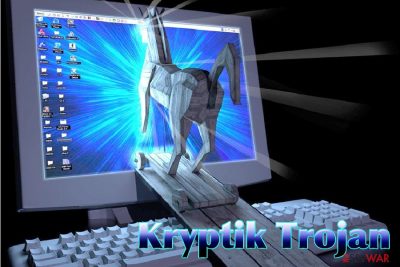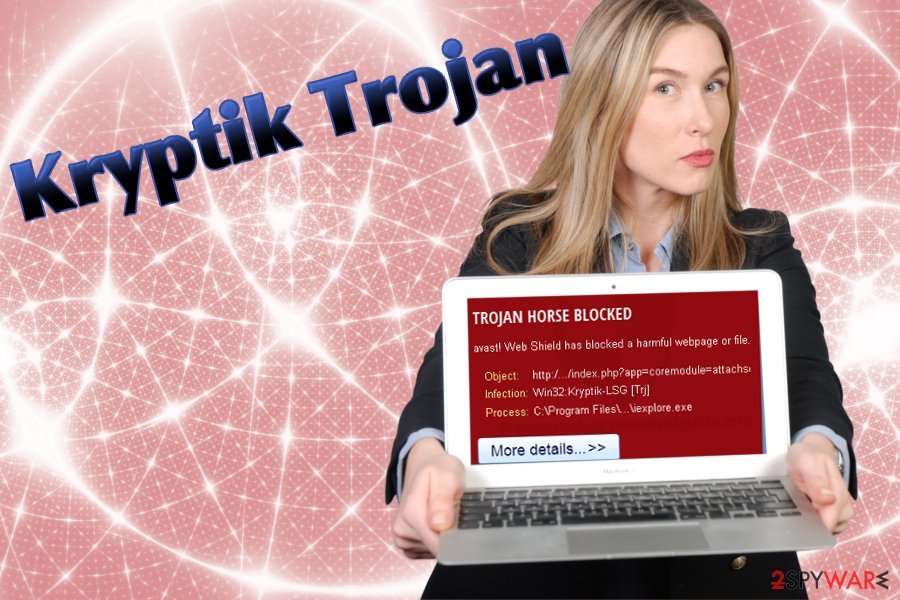Kryptik Trojan (Virus Removal Guide) - Free Instructions
Kryptik Trojan Removal Guide
What is Kryptik Trojan?
Kryptik Trojan is a dangerous malware that can steal your sensitive data and severely damage your computer

Win32:Kryptik is a trojan that typically enters users machines via infected installers and then tries to acquire administration rights. By doing so, Kryptik virus can make the needed modifications to registry entries and other settings, which lets it execute each time Windows is booted. The infection is very persistent and hard to detect, as Kryptik trojan deletes its executable file after infiltration.
| SUMMARY | |
| Name | Kryptik trojan |
|---|---|
| Type | Trojan |
| AV detection names | Win32:Kryptik, Win32/Kryptik.BGIS, Win32:Kryptik -LSG [trj], Win32:Kryptik-FOR, TR/PSW.Zbot.AM.17741, Trojan.GenericKD.1130356, Trojan-Spy.Win32.Zbot.nsfm, PWS:Win32/Zbot.gen!AM, Win32/Kryptik.KGY etc. |
| Main dangers | Stolen sensitive information, corrupted files, broken software and hardware |
| Symtoms | Slowdown of the PC, crashing programs, |
| Distribution | Malicious installers from spam emails, infected sites, etc. |
| Elimination | Automatic elimination using security software like FortectIntego or Malwarebytes |
Kryptik Trojan is capable of many malicious acts, such as:
- Legitimate programs can crash, work slow and become nonresponsive;
- The workstation might crash or restart on its own;
- The CPU power might be excessive while trojan is executing its malicious activities;
- Certain files might get deleted (.sol);
- The trojan can enable hackers to take full control of the PC;
- Kryptik can steal sensitive data and transfer it to cybercriminals via encrypted communication (RC4[1] encryption algorithm).
It might be challenging to notice this trojan. Thus, that is another reason to install reputable security software such as FortectIntego or Malwarebytes. These anti-malware programs can detect and remove Kryptik Trojan in Safe Mode with Networking.
Kryptik virus can also modify your browser settings – proxy[2] ones in particular. As a result, you are forced to encounter ads on every website you visit. They can be in the form of pop-ups, deals, banners, hyperlinks, work as redirects, etc. This activity can lead you to malicious websites, where more malware can be implanted into your PC without your knowledge.
Win32:Kryptik also continually attempts to download malicious files from the internet, slowing down your connection speed and the browser. Thus, if your computer and internet speed suddenly started to struggle – it might be the first warning sign.
The virus gathers and sends out the following information:
- Digital certificates and their passwords;
- Users name and computer name;
- Login usernames and passwords for certain programs and services;
- Email address information, including Outlook;
- Operating system version, etc.
As evident, this information can help cybercriminals to obtain extremely sensitive data, like bank account information or other credentials. It goes without saying that such information should be kept private, as it can lead to stolen money or even identity theft.
As we already mentioned, an antivirus program can take care of Kryptik removal. Do not attempt to remove the virus manually as it can lead to permanent damage to your system files. Instead, follow our instructions below this article.

Trojans can enter machines in many different ways
The most prevalent distribution method of trojans is via malicious installers. They can come from websites that are injected with malicious code, hacked sites, repacked/illegal software or its keygens, codecs, fake updates, social media links, and malicious attachments in spam emails.
Thus, to protect themselves from such cyber threats, users should be more careful while browsing the world wide web. We suggest avoiding any third-party websites that have file-sharing features, never using peer-to-peer clients, downloading only original software, deleting spam emails instead of opening their attachments, and securing the PC with powerful anti-malware software.
Kryptik Trojan should be eliminated as soon as possible
Trojans are one of the most dangerous and widely spread malware types. After all, it can lead to total destruction of not only software but hardware too. Thus, it is vital to eliminate the threat before more severe damage is caused.
Security experts from virusler.info.tr[3] advise not to undertake manual Kryptik Trojan removal. This process can only be executed by IT professionals and is too complicated for regular users.
To remove the Kryptik virus safely, download FortectIntego or Malwarebytes, bring it up to date, and perform a full system scan. Do not forget that malicious programs might block the proper operation of security software. Thus, you should reboot your PC in Safe Mode with Networking, as explained below. Removing corrupted registry entries is essential, and the mentioned security tools can take care of that quickly.
Getting rid of Kryptik Trojan. Follow these steps
Manual removal using Safe Mode
To start security software you should boot your PC in Safe Mode with networking. Just follow these steps:
Important! →
Manual removal guide might be too complicated for regular computer users. It requires advanced IT knowledge to be performed correctly (if vital system files are removed or damaged, it might result in full Windows compromise), and it also might take hours to complete. Therefore, we highly advise using the automatic method provided above instead.
Step 1. Access Safe Mode with Networking
Manual malware removal should be best performed in the Safe Mode environment.
Windows 7 / Vista / XP
- Click Start > Shutdown > Restart > OK.
- When your computer becomes active, start pressing F8 button (if that does not work, try F2, F12, Del, etc. – it all depends on your motherboard model) multiple times until you see the Advanced Boot Options window.
- Select Safe Mode with Networking from the list.

Windows 10 / Windows 8
- Right-click on Start button and select Settings.

- Scroll down to pick Update & Security.

- On the left side of the window, pick Recovery.
- Now scroll down to find Advanced Startup section.
- Click Restart now.

- Select Troubleshoot.

- Go to Advanced options.

- Select Startup Settings.

- Press Restart.
- Now press 5 or click 5) Enable Safe Mode with Networking.

Step 2. Shut down suspicious processes
Windows Task Manager is a useful tool that shows all the processes running in the background. If malware is running a process, you need to shut it down:
- Press Ctrl + Shift + Esc on your keyboard to open Windows Task Manager.
- Click on More details.

- Scroll down to Background processes section, and look for anything suspicious.
- Right-click and select Open file location.

- Go back to the process, right-click and pick End Task.

- Delete the contents of the malicious folder.
Step 3. Check program Startup
- Press Ctrl + Shift + Esc on your keyboard to open Windows Task Manager.
- Go to Startup tab.
- Right-click on the suspicious program and pick Disable.

Step 4. Delete virus files
Malware-related files can be found in various places within your computer. Here are instructions that could help you find them:
- Type in Disk Cleanup in Windows search and press Enter.

- Select the drive you want to clean (C: is your main drive by default and is likely to be the one that has malicious files in).
- Scroll through the Files to delete list and select the following:
Temporary Internet Files
Downloads
Recycle Bin
Temporary files - Pick Clean up system files.

- You can also look for other malicious files hidden in the following folders (type these entries in Windows Search and press Enter):
%AppData%
%LocalAppData%
%ProgramData%
%WinDir%
After you are finished, reboot the PC in normal mode.
Remove Kryptik Trojan using System Restore
You can also try to eliminate Kryptik trojan by using System Restore:
-
Step 1: Reboot your computer to Safe Mode with Command Prompt
Windows 7 / Vista / XP- Click Start → Shutdown → Restart → OK.
- When your computer becomes active, start pressing F8 multiple times until you see the Advanced Boot Options window.
-
Select Command Prompt from the list

Windows 10 / Windows 8- Press the Power button at the Windows login screen. Now press and hold Shift, which is on your keyboard, and click Restart..
- Now select Troubleshoot → Advanced options → Startup Settings and finally press Restart.
-
Once your computer becomes active, select Enable Safe Mode with Command Prompt in Startup Settings window.

-
Step 2: Restore your system files and settings
-
Once the Command Prompt window shows up, enter cd restore and click Enter.

-
Now type rstrui.exe and press Enter again..

-
When a new window shows up, click Next and select your restore point that is prior the infiltration of Kryptik Trojan. After doing that, click Next.


-
Now click Yes to start system restore.

-
Once the Command Prompt window shows up, enter cd restore and click Enter.
Finally, you should always think about the protection of crypto-ransomwares. In order to protect your computer from Kryptik Trojan and other ransomwares, use a reputable anti-spyware, such as FortectIntego, SpyHunter 5Combo Cleaner or Malwarebytes
How to prevent from getting trojans
Choose a proper web browser and improve your safety with a VPN tool
Online spying has got momentum in recent years and people are getting more and more interested in how to protect their privacy online. One of the basic means to add a layer of security – choose the most private and secure web browser. Although web browsers can't grant full privacy protection and security, some of them are much better at sandboxing, HTTPS upgrading, active content blocking, tracking blocking, phishing protection, and similar privacy-oriented features. However, if you want true anonymity, we suggest you employ a powerful Private Internet Access VPN – it can encrypt all the traffic that comes and goes out of your computer, preventing tracking completely.
Lost your files? Use data recovery software
While some files located on any computer are replaceable or useless, others can be extremely valuable. Family photos, work documents, school projects – these are types of files that we don't want to lose. Unfortunately, there are many ways how unexpected data loss can occur: power cuts, Blue Screen of Death errors, hardware failures, crypto-malware attack, or even accidental deletion.
To ensure that all the files remain intact, you should prepare regular data backups. You can choose cloud-based or physical copies you could restore from later in case of a disaster. If your backups were lost as well or you never bothered to prepare any, Data Recovery Pro can be your only hope to retrieve your invaluable files.





















